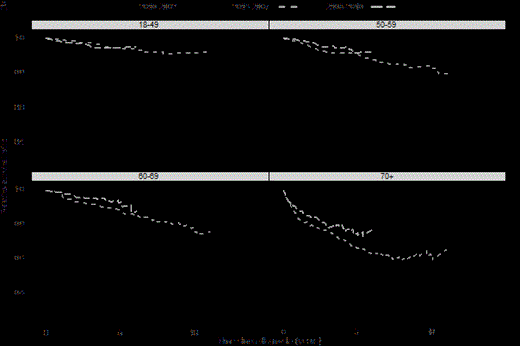Abstract
Introduction
Follicular lymphoma (FL) is the most common indolent lymphoma, with 200-250 cases in Sweden per year. FL is considered incurable, because conventional therapy only leads to temporary remissions of varying length. Studies indicate that survival for patients with FL has improved since the introduction of rituximab. In Sweden first-line rituximab was gradually introduced between 2003 and 2007 and the speed of rituximab adoption varied geographically. In the publication of the first national Swedish guidelines for FL in November 2007, rituximab was recommended as first-line therapy and as maintenance after first relapse.
Methods
We conducted a nationwide, population-based registry study to assess patterns of FL survival before and after the introduction of first-line rituximab and to identify prognostic factors in the rituximab era. In the Swedish Lymphoma Registry (SLR) 2641 patients were identified with a FL diagnosed between January 1, 2000 and December 31, 2010. Clinical data, including first-line treatment were collected from the SLR. Overall survival (OS) and relative survival (RS) were estimated by calendar period (the pre-rituximab era 2000-2002, the transitional period 2003-2007 and the established period 2008-2010) and national health care region.
Results
First-line rituximab use increased gradually during the study period (2000-2002, 13%; 2003-2007, 61%; 2008-2010, 86%). During the transitional period, one health care region incorporated first-line rituximab quickly (92% first-line rituximab use) and one slowly (31%), whereas the remaining regions showed a moderate use of first-line rituximab (in total, 62%). OS and RS improved incrementally with each calendar period (P < 0.00005) (Figure 1A). Survival differed, during the transitional period, between regions with different rituximab use (OS, P = 0.039) (Figure 1B). After the national guidelines were published, no regional differences in use of first-line rituximab remained (P = 0.91). The improvement in OS and RS during the study period was greater in women than in men (Figure 1C). Survival improved in all age groups, but most in elderly patients (Figure 2).
Conclusions
The policy of first-line rituximab has resulted in a nationwide improvement in FL survival in Sweden. Women and elderly patients have benefited the most from rituximab.
Cumulative relative survival of follicular lymphoma by (A) calendar period of diagnosis, (B) regional adoption of rituximab during 2003-2007, and (C) calendar period of diagnosis and gender.
Cumulative relative survival of follicular lymphoma by (A) calendar period of diagnosis, (B) regional adoption of rituximab during 2003-2007, and (C) calendar period of diagnosis and gender.
Can't read 3B2 tag because stream don't exist.Tag: Figure_31
No relevant conflicts of interest to declare.
Author notes
Asterisk with author names denotes non-ASH members.



This feature is available to Subscribers Only
Sign In or Create an Account Close Modal